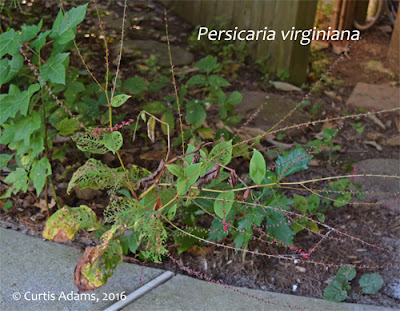white avens (Geum canadense) and great blue lobelia (Lobelia siphilitica) as well as introduced species like mock strawberry (Duchesnea indica) and a cultivated species of columbine that had been reseeding itself for a number of years through the ivy.
 |
| In September as the flowers of the jumpseed are opening up, something goes after the leaves, eventually skeletonizing them. |
After letting this area go for several years and not seeing any improvement I decided it was time to make it a little more formal by adding more defined layers to the garden. While a random planting works in the distance, close up the human eye is looking for more defined structure and order. In general, lower plants will go in the foreground, near the stepping stones. Medium sized perennials go to the middle and the bushy goatsbeard stays in the back. This new planting will be easier to maintain because it will be easier to identify the 'weedy' plants over a background of low sedges than it was before.
First I removed as much of the jumpseed as I could see. Then I pulled out any encroaching English ivy and honeysuckle. I also pulled out some native trees that seeded in, like butternut and box elder. The lower-growing alumroot was already near the path. For additional low-growing plants, I transplanted several species of sedges from elsewhere on the property. Their lower stature, defined form, and contrasting texture will help show off the taller perennials.
 |
| Here's the garden after removing the jumpseed. The back right is dominated by two goatsbeard, and the fencing is getting covered with virgin's bower (Clematis virginiana) that was planted in 2013. |
The Solomon's seal was doing well, but they were getting hidden by the jumpseed. I put some sedges around the Solomon's seal to give them some vertical space.
One of the sedges I chose has 1/4-1/2" wide blades and grows in clumps about a foot wide. These went in along the path and are scattered with the perennials to provide some height variation. Also it's evergreen so it will be around all year. The white avens that is indigenous to this site has deeply lobed leaves that blend well with the alumroot. The avens can get lanky and will benefit from some cutting back late in the season.
The other sedge is also clumping but has very thin, light green blades. I'm pretty sure this is rosey sedge (Carex rosea). It grows very well on partly sunny to shady sites.
 |
| This unknown columbine was planted by a previous owner and has been reseeding itself for a number of years. Definitely not a native, but it looks good here. |
So here's the garden after clean-up and planting. It looks a little sad now since leaves are falling off and the plants are settling in for winter.
 |
| Weeded and replanted, we'll see what happens next year. |
 |
As drawn here the goatsbeard, Indian pinks, and columbine are shown in bloom.
The sedges and alumroot line the stepping stones, from lower right to upper left.
|








